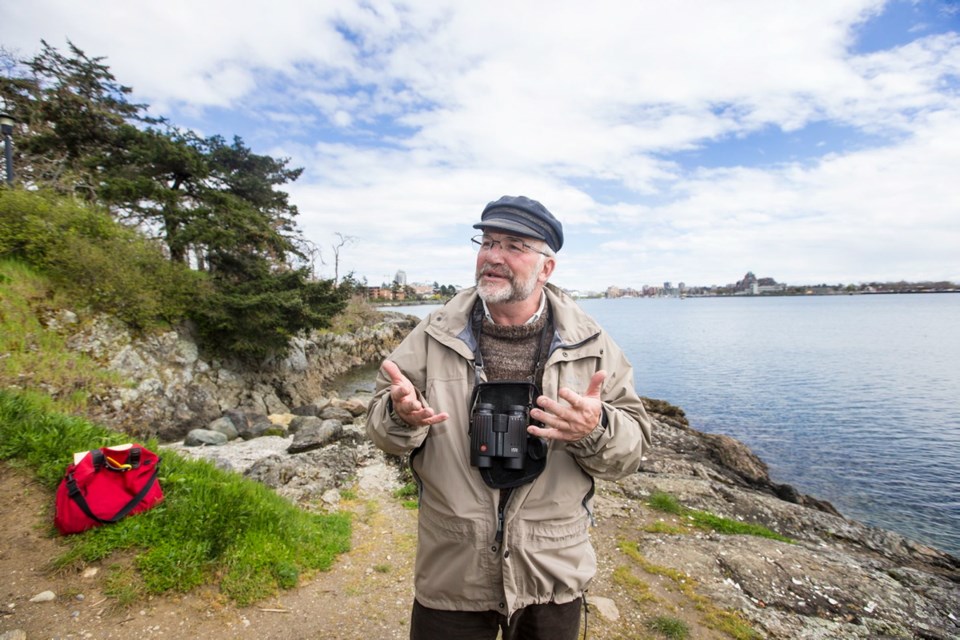From a rocky outcrop along the coastal path that leads from Esquimalt to downtown Victoria, Jacques Sirois looks through binoculars across Victoria Harbour.
The retired ornithologist has just pointed out dozens of buffleheads — tiny blackish and white seafaring ducks — when he spots a surprise.
“Oh, look at that. We have one, two, three, four red-throated loons from the Arctic. I’ve never, ever seen so many in Victoria Harbour,” he says with the kind of glee only a true birder can muster.
The return of many bird populations to Greater Victoria’s shores is just one part of a larger story that Sirois says goes too easily unnoticed. Victoria’s waters are cleaner than they’ve been in 60 years, he says, which means all kinds of species are thriving. “The story has been unfolding for a few decades. And now it’s getting to be downright interesting.”
Sirois’s expertise centres on an area designated as the Victoria Harbour Migratory Bird Sanctuary, which covers an area from Ten Mile Point to Macaulay Point and up the Gorge Waterway to Portage Inlet.
The sanctuary was created 94 years ago, to control market hunting, which first became popular during the gold rush. Similar sanctuaries were created at Shoal Harbour and Esquimalt Lagoon.
By the 1980s, the city’s growth and heavy industrialization had made the designation irrelevant. There was no more hunting and almost no more birds, he says.
Ironically, as an employee of the Canadian Wildlife Service, Sirois himself had argued the designation should be removed.
“I was part of the team trying to get rid of it.”
Now, Sirois says, it’s a different story.
“Because of cleanups, de-industrialization and ecological restorations at several sites, the wildlife is coming back. And what is spectacular is that it’s right in the city.”
The movement behind the cleanup has been relatively decentralized, involving dozens of volunteer groups, environmental organizations and government agencies over the years.
Salmon is rebounding in the Colquitz River and Craigflower Creek, thanks to streamkeepers and stewards. The Western Purple Martin Foundation has erected nesting boxes for thousands of pairs of the at-risk species and the World Fisheries Trust headed an Olympia-oyster relocation project in the Gorge Waterway.
Just beyond the sanctuary boundary, CFB Esquimalt has a $160-million Esquimalt Harbour remediation project underway. Since it was approved in 2015, about 35,000 cubic metres of contaminated sediment has been removed from the harbour floor.
“Imagine 150 years of shipbuilding, ship repair, ship maintenance, sawmills — all sorts of other activities that have occurred in the harbour and have resulted in pollution,” says Mike Bodman, environment officer at CFB Esquimalt.
Bodman estimates 200,000 cubic metres of sediment could be removed by 2020.
“We certainly expect the removal of the sediment will also reduce the levels of contaminants we find in marine life in the harbour,” he says.
But it’s not all sunshine and roses.
While birds are returning, their numbers are nowhere near where they were decades ago, Sirois says.
And the Gorge Waterway is in danger of becoming a victim of its own success.
John Roe, who spearheaded cleanup efforts as part of the Veins of Life volunteer group, says the clean water is attracting human activity with negative consequences.
More waterfront properties are going up and trees are coming down to improve the view. Unlicensed docks have been installed. And more paddlers could damage sensitive areas, such as the mouth of the Colquitz River.
Further, stormwater runoff from streets and industrial sites continues to bring contamination and effluent into the waterway, which only gets worse as the population densifies, Roe says.
Roe has his sights set on two responses: creation of a stormwater management plan and a watershed management authority. “The problem is that we have 19 management bodies in the whole area and not any single one is taking responsibility,” Roe says.



